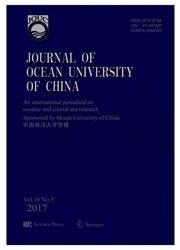

 中文摘要:
中文摘要:
We sampled the sediments of the East China Sea during 2005 and 2006, and analysed the contents of the biogenic matters: biogenic silica, organic carbon, and organic nitrogen. From the surface distribution we found the contents of these substances to be in the ranges of 0.72%-1.64%, 0.043%-0.82%, and 0.006%-0.11%, respectively. Their distributions were similar to each other, being high inside the Hangzhou Bay and low outside the bay. The vertical variations of the contents were also similar. In order to discuss the relation between them we analysed the variations of content with depth. They increased in the first 7 cm and then decreased with depth. The peaks were found at depths between 20 to 25 cm. The distribution of carbonate showed an opposite trend to that of biogenic matters. The content of total carbon was relatively stable with respect to depth, and the ratio of high organic carbon to carbonate showed a low burial efficiency of carbonate, which means that the main burial of carbon is organic carbon. In order to discuss the source of organic matters, the ratio of organic carbon to organic nitrogen was calculated, which was 8.01 to 9.65, indicating that the organic matter in the sediments was derived mainly from phytoplankton in the seawater.
 英文摘要:
英文摘要:
We sampled the sediments of the East China Sea during 2005 and 2006, and analysed the contents of the biogenic mat- ters: biogenic silica, organic carbon, and organic nitrogen. From the surface distribution we found the contents of these substances to be in the ranges of 0.72%-1.64%, 0.043%-0.82%, and 0.006%-0.11%, respectively. Their distributions were similar to each other, being high inside the Hangzhou Bay and low outside the bay. The vertical variations of the contents were also similar. In order to discuss the relation between them we analysed the variations of content with depth. They increased in the first 7 cm and then de- creased with depth. The peaks were found at depths between 20 to 25 cm. The distribution of carbonate showed an opposite trend to that of biogenic matters. The content of total carbon was relatively stable with respect to depth, and the ratio of high organic carbon to carbonate showed a low burial efficiency of carbonate, which means that the main burial of carbon is organic carbon. In order to discuss the source of organic matters, the ratio of organic carbon to organic nitrogen was calculated, which was 8.01 to 9.65, indicat- ing that the organic matter in the sediments was derived mainly from phytoplankton in the seawater.
 同期刊论文项目
同期刊论文项目
 同项目期刊论文
同项目期刊论文
 期刊信息
期刊信息
